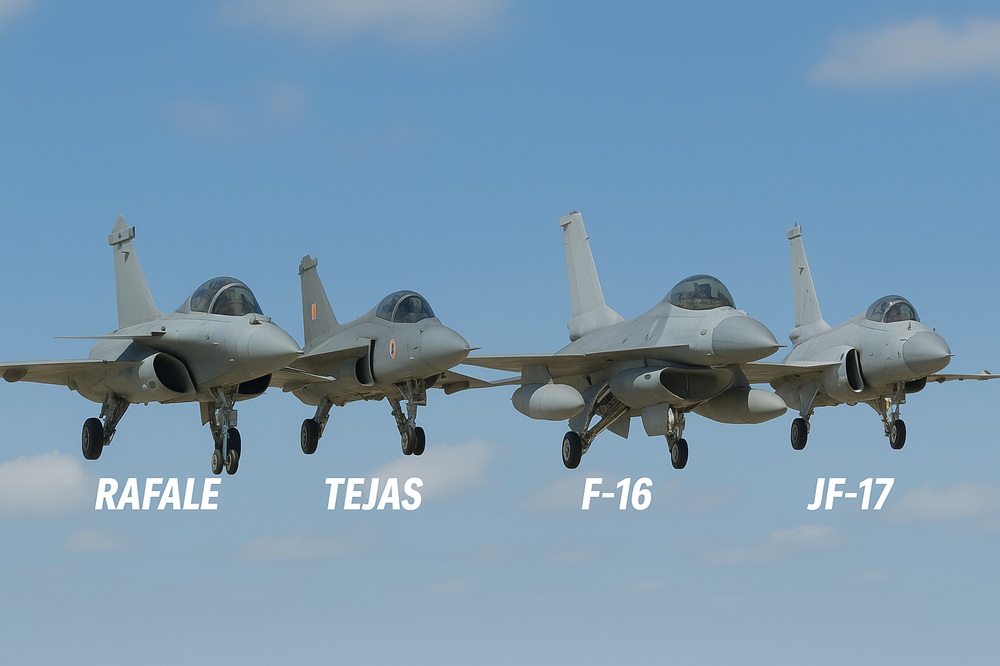Modern air combat is shaped by technological edge, multirole capabilities, and cost-effectiveness. Today, we compare four prominent fighter jets: the French Dassault Rafale, India’s indigenous HAL Tejas, the American F-16 Fighting Falcon, and the Sino-Pakistani JF-17 Thunder.
1. Overview
| Fighter Jet | Origin | Generation | Role | First Flight |
|---|---|---|---|---|
| Rafale | France | 4.5+ Gen | Multirole | 1986 |
| Tejas | India | 4+ Gen | Light Multirole | 2001 |
| F-16 | USA | 4th Gen | Multirole | 1974 |
| JF-17 | China/Pakistan | 4th Gen | Light Multirole | 2003 |
2. Airframe and Design
-
Rafale: Twin-engine, delta wing with canards, stealth features, optimized for agility and survivability.
-
Tejas: Single-engine delta wing, composite-heavy for reduced radar signature and weight.
-
F-16: Iconic bubble canopy, single-engine with relaxed stability design for high maneuverability.
-
JF-17: Single-engine lightweight fighter, conventional design, simpler than others but modernized in Block III variant.
3. Avionics and Radar
| Jet | Radar | Avionics |
|---|---|---|
| Rafale | Thales RBE2 AESA | Advanced EW suite (SPECTRA), sensor fusion, glass cockpit |
| Tejas Mk1A | EL/M-2052 AESA (or Uttam AESA) | Indigenous digital flight control, glass cockpit |
| F-16 (Block 70/72) | AN/APG-83 AESA | Advanced cockpit, Link-16, helmet-mounted cueing |
| JF-17 Block III | KLJ-7A AESA | Improved avionics, HMD, basic data link systems |
4. Weapons & Payload
-
Rafale: Over 9.5 tons of payload, includes Meteor BVRAAM, SCALP cruise missile, Exocet.
-
Tejas: ~5.3 tons payload, equipped with Astra, Derby, BrahMos-NG (planned).
-
F-16: ~7.7 tons payload, wide range of US/NATO weapons, AMRAAM, JDAMs.
-
JF-17: ~3.6 tons payload, includes Chinese PL-15, anti-ship missiles, and PGMs.
5. Engine and Performance
| Jet | Engine | Thrust | Max Speed | Range |
|---|---|---|---|---|
| Rafale | 2× Snecma M88 | 75 kN each | Mach 1.8+ | ~3,700 km (with tanks) |
| Tejas | 1× GE F404 | 84 kN | Mach 1.6 | ~3,000 km |
| F-16 | 1× GE F110 | ~130 kN | Mach 2.0 | ~4,200 km |
| JF-17 | 1× RD-93 | 84 kN | Mach 1.6 | ~2,000–3,000 km |
6. Operational History & Cost
-
Rafale: Combat-proven in Libya, Mali, Syria; expensive (~$100M+ per unit); small user base.
-
Tejas: Limited operational use, but growing indigenous support and export interest (e.g., Argentina, Egypt).
-
F-16: Most widely used fighter globally; highly battle-tested; unit cost ~$30–40M.
-
JF-17: Operational with Pakistan, Myanmar, Nigeria; low cost (~$25–30M); not yet tested in high-end combat.
7. Strengths & Weaknesses
| Jet | Strengths | Weaknesses |
|---|---|---|
| Rafale | Superior avionics, stealth, weapons | High cost, complex logistics |
| Tejas | Indigenous, agile, cost-effective | Limited range and payload, still maturing |
| F-16 | Proven, highly upgradable | Aging platform, export dependent on US approval |
| JF-17 | Affordable, easy to maintain | Lower sophistication, unproven against top-tier jets |
8. Conclusion
Choosing between these jets depends heavily on strategic needs, budget, and combat roles.
-
Rafale suits air forces seeking a cutting-edge, full-spectrum multirole fighter.
-
Tejas is ideal for countries looking to build local aerospace capabilities.
-
F-16 remains a versatile, cost-effective warhorse with decades of proven performance.
-
JF-17 offers budget-conscious air forces a modern platform with decent capabilities.
Each jet holds its ground in specific contexts. In real combat, tactics, pilot training, and integrated support systems often outweigh pure specifications.
